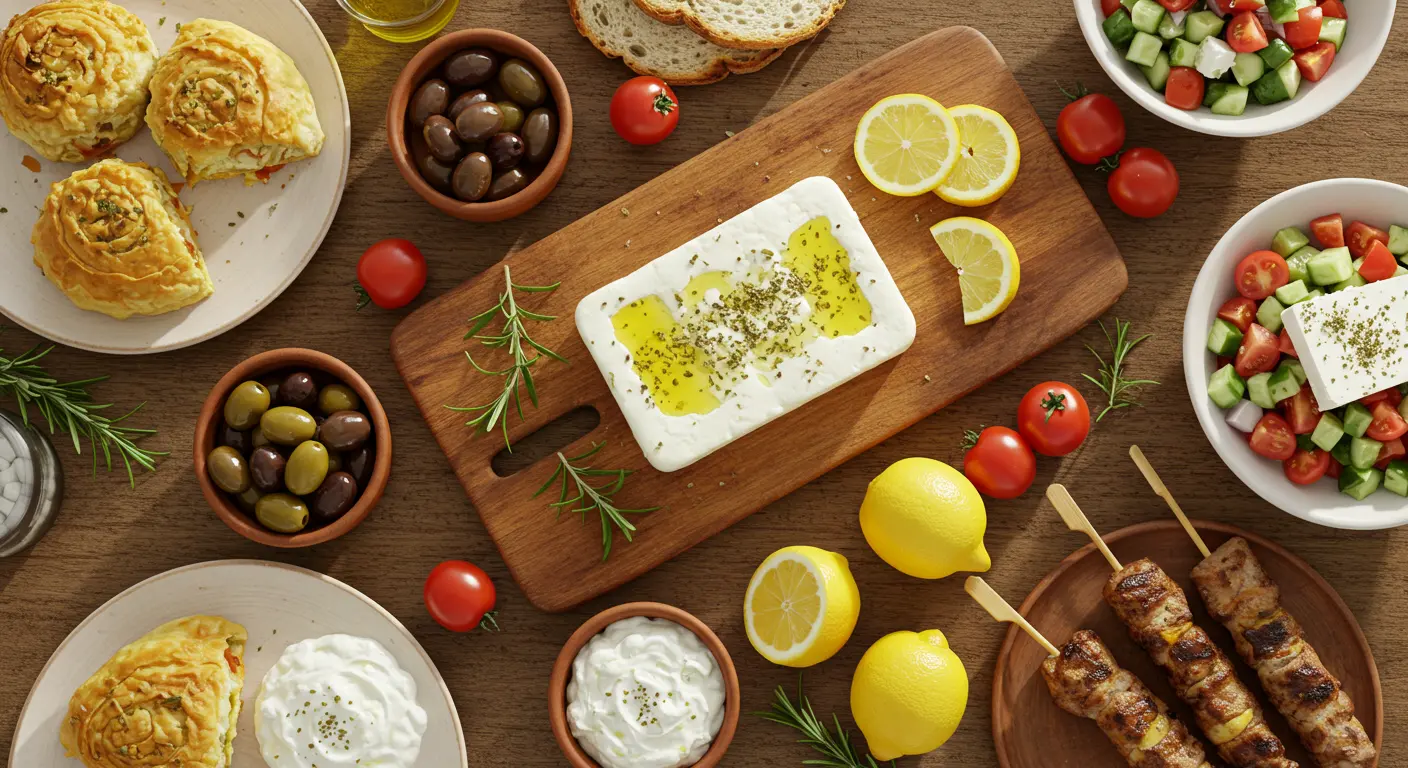Table of Contents
More Than a Gyro: A Flavorful Journey into Greek Food for Beginners
Picture this: the sun-warmed aroma of oregano and lemon, the sizzle of olive oil in a pan, the cheerful clatter of plates sharing a meal that feels like a celebration. If you think Greek food begins and ends with a gyro from a food court, you’re in for one of the most delightful culinary surprises of your life.
Greek cuisine isn’t just about what you eat; it’s a window into a culture built on philoxenia (love for strangers), vibrant history, and the stunningly simple art of turning a few fresh ingredients into something magical. It’s the heart of the famously healthy Mediterranean diet, but honestly? It tastes too good to be called a “diet.”
Feeling a little intimidated? Don’t worry. This guide is your friendly invitation to the world of Greek food. We’ll walk through the essential flavors, must-try dishes, and even some practical tips so you can order with confidence at a taverna or recreate a taste of the Aegean in your own kitchen. Let’s dive in.
The Soul of the Plate: What Makes Greek Food Greek?
Before we get to the specific dishes, it helps to understand the philosophy. Greek cooking is, at its core, a celebration of the land and sea. It’s rustic, honest, and relies heavily on the quality of its ingredients rather than complex techniques. A few key pillars hold everything up:
- The Liquid Gold: Olive Oil: This isn’t just a cooking fat; it’s a fundamental flavor. Greeks use high-quality extra virgin olive oil in staggering quantities—in salads, for frying, drizzled over cooked food, even in some cakes. It’s the irreplaceable base note of the cuisine.
- The Holy Trinity of Herbs: Oregano, Mint, and Dill: Walk through a Greek hillside and you’ll smell these herbs growing wild. Oregano is the most iconic, sprinkled over everything from salads to grilled meat. Mint and dill bring a fresh, aromatic quality to everything from meatballs to pies.
- A Touch of the Sea: Lemon & Garlic: The bright, sharp zing of lemon juice cuts through the richness of olive oil and meat like nothing else. And garlic? Let’s just say it’s a beloved, non-negotiable guest in most savory dishes.
- The Salty Bite: Feta & Olives: These two are the salty soulmates of the Greek table. Feta cheese, made from sheep’s or goat’s milk, is briny and crumbly. Kalamata olives, with their deep purple skin and meaty texture, are the most famous variety, but you’ll find dozens of kinds.
I remember my first trip to a farmer’s market in Crete. The tomatoes smelled like sunshine, the olives were swimming in fragrant oil, and the old woman selling herbs insisted I taste a sprig of wild oregano. That’s when it clicked—this cuisine is alive.
Your First Feast: A Handful of Can’t-Miss Greek Dishes
Okay, let’s get to the good stuff. Here’s a starter pack of dishes you absolutely need to know.
The Starters & Mezedes (Meh-ZEH-thes)
In Greece, eating is a social event that can last for hours. Meals often start with mezedes—small plates meant for sharing. It’s the perfect way to sample a bit of everything.
- Tzatziki (tsah-TZEE-kee): You might have tried it, but have you had the real deal? This creamy dip is a cool blend of thick Greek yogurt, shredded cucumber, loads of garlic, and a hint of dill. It’s the perfect companion for warm pita bread or a condiment for grilled meats. Pro tip: The best tzatziki is always homemade and served chilled.
- Dolmades (dol-MAH-thes): These are grape leaves stuffed with a mixture of rice, herbs, and sometimes minced meat. They can be served cold (with a lemony sauce) or warm. They’re little flavor parcels that are surprisingly light and refreshing.
- Spanakopita (spa-na-KO-pita): Imagine flaky, buttery phyllo dough filled with a savory mixture of spinach, feta cheese, onions, and herbs. This savory pie is a staple in bakeries and homes across the country. It’s the ultimate comfort food.
The Main Events
- Moussaka (moo-sa-KAH): Often called Greece’s version of lasagna, but that doesn’t quite do it justice. This is a serious casserole of layered eggplant, spiced minced meat (usually lamb or beef), and a rich, creamy béchamel sauce that gets golden-brown on top. It’s hearty, decadent, and a true centerpiece dish.
- Souvlaki & Gyros: Let’s clear this up! Souvlaki means “little skewers” and refers to cubes of meat (pork, chicken, or lamb) grilled on a stick. Gyros (YEE-ros) is the meat—typically pork or chicken—stacked on a vertical rotisserie, thinly sliced, and then stuffed into a pita wrap with tomato, onion, tzatziki, and fries. Both are delicious, affordable, and the quintessential Greek street food.
- Fresh Grilled Fish: On the islands and coastal towns, you’ll often choose your fish straight from a ice-filled display. It’s simply grilled whole, drenched in olive oil and lemon, and served with a side of horta (boiled wild greens). The simplicity is the point—it’s all about the pristine freshness of the catch.
A Sweet Ending
Greek desserts are often not overly sugary, instead relying on honey, nuts, and phyllo dough.
- Baklava (ba-kla-VA): Layers of paper-thin phyllo dough, chopped nuts (usually walnuts or pistachios), and a sweet syrup made of honey and lemon. It’s sticky, sweet, and utterly irresistible.
- Loukoumades (loo-koo-MA-thes): Think of these as Greek donut holes. They’re deep-fried balls of dough drenched in honey syrup and sprinkled with cinnamon and chopped walnuts. Hot, crispy, and heavenly.
Navigating a Greek Menu & Dining Like a Local
Walking into a traditional taverna can be overwhelming. Here’s how to handle it like a pro.
- It’s Okay to Point: Don’t be shy! In many family-run tavernas, the best dishes are in a glass display case. It’s perfectly acceptable to walk up, point at what looks good, and ask, “Ti einai afto?” (What is this?).
- Share Everything: Order a few mezedes for the table to share, then perhaps one main per person. This is the spirit of Greek dining.
- The Bill Won’t Come Automatically: Meals are leisurely. To get the bill, you’ll usually need to catch your server’s eye and ask, “To logariasmo, parakalo” (The bill, please). Rushing is frowned upon.
- When in Doubt, Order the House Wine: Ask for “Krasi tou oikogeneiakou” (house wine). It’s often served in a carafe and is surprisingly good and inexpensive.
For an authentic deep dive into regional specialties and recipes, I always turn to the work of renowned culinary historian and author Diane Kochilas. Her website and books are an incredible resource for anyone wanting to understand the depth of Greek cuisine. You can explore her work at www.dianekochilas.com.
Bringing the Taverna Home: A Simple Greek Salad Recipe
You don’t need a plane ticket to enjoy authentic Greek food. The famous Horiatiki, or Greek Village Salad, is a perfect starting point. The secret? No lettuce! And the best ingredients you can find.
Ingredients:
- 3-4 ripe tomatoes, cut into chunks
- 1 cucumber, sliced into half-moons
- 1 red onion, thinly sliced
- 1 green bell pepper, sliced (optional)
- A handful of Kalamata olives
- A large block of high-quality Greek feta cheese
- 2-3 tablespoons of extra virgin olive oil
- 1 teaspoon of dried oregano
- Salt to taste
Instructions:
- In a large bowl, gently combine the tomatoes, cucumber, onion, and bell pepper.
- Place the whole block of feta on top of the vegetables. Do not crumble it!
- Scatter the olives around the feta.
- Drizzle generously with olive oil.
- Sprinkle the oregano and a pinch of salt directly over the feta and vegetables.
- Serve immediately with crusty bread to sop up the incredible juices at the bottom of the bowl. It’s a meal in itself.
Frequently Asked Questions About Greek Food
Q: Is Greek food always healthy?
A: Generally, yes! The Mediterranean diet, with its focus on olive oil, vegetables, legumes, and lean proteins, is one of the healthiest in the world. However, dishes like moussaka or fried appetizers are indulgent. Balance is key, just like in Greece.
Q: I’m a vegetarian. Will I find options?
A: Absolutely. Greek cuisine is a vegetarian’s paradise. From feta and horiatiki salads, to gigantes (giant beans in tomato sauce), dolmades, spanakopita, and a huge variety of grilled vegetables and dips, you’ll have plenty to choose from.
Q: What’s the difference between Greek yogurt and regular yogurt?
A: Greek yogurt is strained, which removes much of the whey. This results in a much thicker, creamier, and protein-packed yogurt compared to its unstrained counterparts. It’s a staple for breakfast, in sauces, and even in baking.
Q: Is lamb the most common meat in Greece?
A: While lamb is iconic (especially for Easter), pork is actually the most commonly consumed meat in everyday Greek cooking, particularly in souvlaki and gyros. Chicken is also very popular.
Your Greek Food Adventure Awaits
So, there you have it. Greek food is a vibrant, living tradition that’s about so much more than just filling your stomach. It’s about sunshine, shared plates, and the profound joy of a simple, well-made meal. It’s a cuisine that welcomes everyone to the table.
Your next step? Find a well-reviewed local taverna and order something you’ve never tried before. Or, better yet, grab some good olive oil, a block of feta, and make that horiatiki salad. Your taste buds will thank you.
Kali Orexi (That’s “bon appétit” in Greek.)




